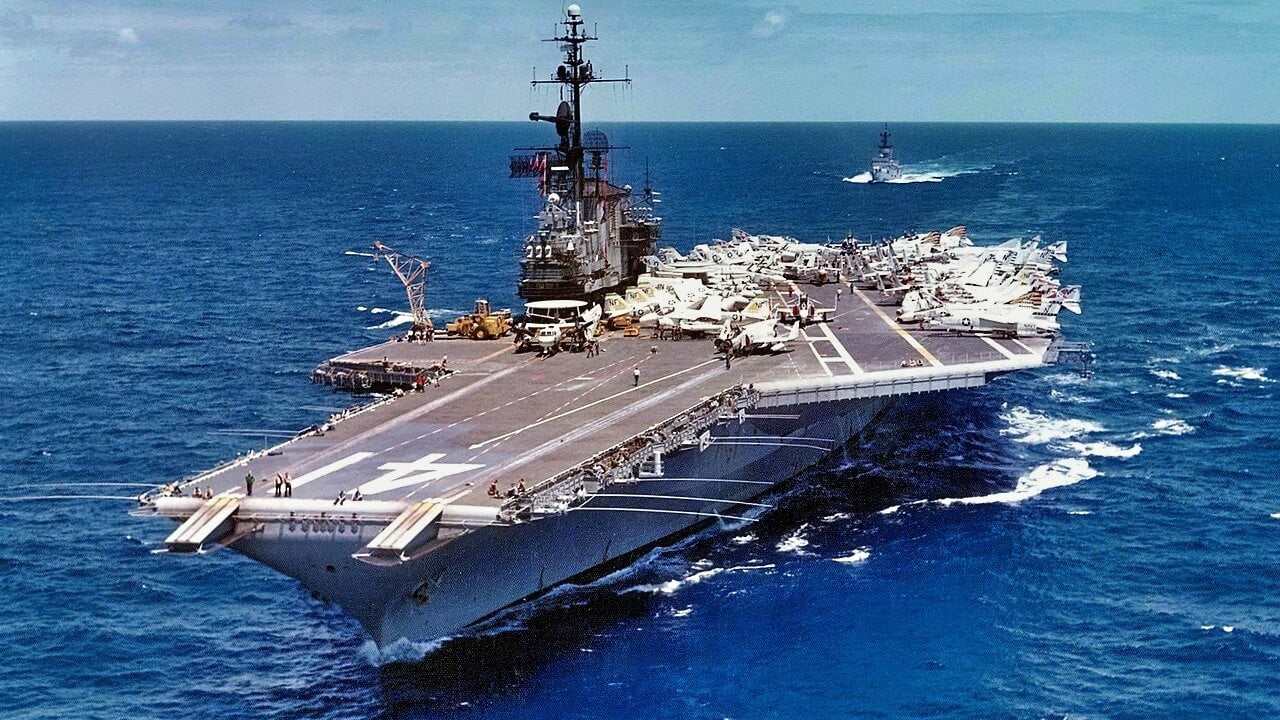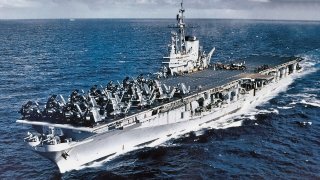The Midway-Class Was the Unstoppable U.S. Navy Aircraft Carrier
The Midway-class aircraft carriers, first launched in 1945, became foundational to the U.S. Navy's early Cold War operations. Notable for their robust design incorporating lessons from WWII, these carriers were initially the world's largest warships and the first to carry nuclear armaments, despite being conventionally powered.
Summary: The Midway-class aircraft carriers, first launched in 1945, became foundational to the U.S. Navy's early Cold War operations. Notable for their robust design incorporating lessons from WWII, these carriers were initially the world's largest warships and the first to carry nuclear armaments, despite being conventionally powered.
-Continuously updated, the Midway-class featured innovations like armored flight decks and longer, angled decks for jet operations.
-Their extensive service life included roles in major conflicts like the Vietnam War and the Persian Gulf War, demonstrating their enduring strategic value.
Midway-Class Aircraft Carriers: Titans of the Cold War Fleet
The Midway-class aircraft carrier was a workhorse of the United States Navy. First deployed by the Navy in September 1945, these boats became the backbone of America’s postwar fleet for the first 15 years of the Cold War.
Beyond that time, the Midway-class continued to serve with distinction until 1992, when it was ultimately retired. It is the only non-Essex-class carrier to be preserved as a museum ship which can be visited by anyone at San Diego Harbor (this author went multiple times as young man and highly recommends it).
The Ultimate Aircraft Carrier
The Navy envisioned the Midway-class as the ultimate World War II aircraft carrier design. Navy engineers worked in critical lessons learned from the Second World War into the basic design of these warships. The warships were bigger, better protected, and more capable than were their WWII predecessors.
In fact, these carriers would serve as the testbed for future designs of even more capable nuclear-powered aircraft carriers, like the Kitty Hawk-class.
The Midway-class was also the first US carrier to carry an armament of nuclear weapons onboard. Although, the carrier was steam-powered not nuclear-powered, it set several precedents that would eventually go into the first US nuclear carrier designs.
For example, the Midways were designed with armored flight decks.
Here’s another fun fact for you to use at your local bar’s next trivia night: for the first decade of her existence, the USS Midway (CV-41) was the largest warship in the world. This “beefier” baby was designed for waging war against a competent near-peer foe that would be able to dish out a bruising on any potential US carrier.
As the Cold War progressed in the immediate aftermath of the Second World War, the Midway became a testbed for all future carrier design in the US fleet.
By the 1950s, in fact, the Navy would refit the Midway-class carriers with longer, angled decks to accommodate jet fighters. One of the reasons behind the Midway-class carrier’s longevity in service is because the Navy paid for multiple refits of the great warships to modernize them.
Due to the Navy’s consistent care and investment in the Midway-class, the USS Midway fired the first shots in the 1991 Persian Gulf War!
What’s more, the Midways were designed with an expanded offensive air capability. Unlike its World War II predecessors, the Essex-class, the Midways could carry up to 137 aircraft.
In keeping with the lessons learned fighting the Japanese in the Second World War, the Navy built the Midways with a sweeping anti-aircraft weapons capability. Further, the crew compartments were both larger and better protected than were the previous American carriers that fought in WWII.
The Midway-Class Specs
One of the refits allowed for the Midways to carry Regulus surface-to-surface missiles. Another refit later in the carrier’s service life allowed for the Midways to possess Sea Sparrow surface-to-air missiles (SAM) and Close-in Weapons Systems (CIWS) that were used for defending the carriers from potential attack.
Three ships of this class were built by the Navy. The first was the namesake of the class, USS Midway (CV-41), which served from 1945-92, USS Franklin D. Roosevelt (CV-42) which served from 1945-77, and USS Coral Sea (CV-43), which served from 1947-90.
These boats were equipped with 18, 5-inch (127 mm)/.54 caliber guns. They came with 21, 40 mm Bofors quad guns as well as 28, 20 mm Oerlikon twin guns. After these boats were refitted, they carried two, Mk.29 launchers that could fire RIM-7 Sea Sparrow missiles. They also had two, M.15 Phalanx CIWS weapons. These boats were powered by 12, 565 PSI boilers, which in turn powered Westinghouse steam turbines (212,000 shp/158 MW).
So, these boats not a nuclear-powered carriers but they were potent conventionally powered boat.
Further, the Midway-class 60,000 tons when fully loaded and 46,000 tons when she traveled light. The boat could also chug along at around 35 miles per hour. Back in those days, that speed meant tracking and hitting such a warship would be very difficult for anti-ship missiles. Today, unfortunately, the advent of anti-access/area denial (A2/AD) means that even speeds like this for such a large ship won’t necessarily protect America’s newer carriers from A2/AD attack.
The Midway-class saw action in every post-World War II conflict and made a name for itself in each war it participated in. During the Vietnam War, the USS Midway was there for the Fall of Saigon, supporting Operation Frequent Wind (the evacuation of US personnel from Vietnam) in 1975.

There are few carrier classes that have enjoyed the legendary status that the Midway-class engendered for itself. The Forrestal-class supercarrier was the immediate successor to the Midways but the spirit of the Midway-class lives on throughout every future carrier in the fleet.
About the Author
Brandon J. Weichert, a National Interest national security analyst, is a former Congressional staffer and geopolitical analyst who is a contributor at The Washington Times, the Asia Times, and The-Pipeline. He is the author of Winning Space: How America Remains a Superpower, Biohacked: China’s Race to Control Life, and The Shadow War: Iran’s Quest for Supremacy. His next book, A Disaster of Our Own Making: How the West Lost Ukraine, is due October 22 from Encounter Books. Weichert can be followed via Twitter @WeTheBrandon.


